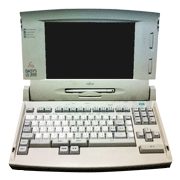Fujitsu announced the OASYS LX-3000, the first word processor to feature a touch-sensitive screen for easy operation by touch, in October 1994. Characters could also be entered by hand using the stylus pen accessory.
- The OASYS LX-3000 had the following features:
- (1)Touch operation
- The OASYS LX-3000 was designed so that anyone could easily access its word processing functions. The touch-sensitive screen made it possible to select functions, specify operations, or indicate text-entry positions directly on the screen. The LX-3000 also accepted handwritten inputs with the stylus pen.
- (2)Full-color printing
- Color document or letter printing was possible using the 115 color samples included with the unit.
- (3)Built-in image sca
- The LX-3000 could scan illustrations, photos, and applications and other forms and then print, copy, or fax the images.
- (4)Other features
- The LX-3000 came standard with five outline fonts: Mincho, Gothic, Mouhitsu (Kaisho), Maru Gothic, and Edo.
- Zoom printing gave users the flexibility to select exact print enlargements or reductions.
| Model name | LX-3000 | |
|---|---|---|
| Introduced | October 1994 | |
| Floppy drive | One 3.5-inch (2DD/2HD*1) | |
| FROM card | One slot | |
| Scanner | Scanning speed | ~55 sec. (A4 page) |
| Scanning resolutions | Fine mode: 400 dpi (up to postcard sizes) Normal mode: 200 dpi (up to A4 sizes) |
|
| Fax mode | 64-level grayscale (in Fine mode) 16-level grayscale (in Normal mode) |
|
| Communication interface | Equipped with an RS-232C*2 | |
| Modem | Data mode | Communication speeds: 300, 1200, 2400 bps (MNP Class 5*3) Line format: telephone subscriber line Communication format: full duplex (compliant with ITU-T*4 V.21, V.22, V.22bis, V.42, and V.42bis and Bell*5 103 and 212A standards) |
| Fax mode | Communication speeds: 300, 2400, 4800, 7200, 9600 bps Line format: telephone subscriber line Communication format: half duplex (compliant with ITU-T V.29, V.27ter, V.21ch2 standards) Transmission protocol: G3*6 ITU-T T.30 compliant Fax control: EIA / TIA*7 Class 2 compliant Data compression format: MH compression*8 |
|
| Keyboard | Thumb shift keyboard (compliant with the NICOLA standard) or JIS keyboard | |
| External dimensions [mm] | 374 x 364 x 102 (w x d x h) (excluding protruding parts) | |
| Weight | 5.8 kg | |
| Power consumption | 75 W max. / 73 W rated | |
*1. 2HD/2DD: Two different floppy disk recording densities. 2HD indicates two-sided high-density double-track recording, and 2DD indicates two-sided, double-density double-track recording.
*2. RS-232C: Recommended Standard 232 Version C. The most common standard for serial interface communications. Frequently used to connect computers with peripheral devices such as printers and modems.
*3. MNP: Microcom Network Protocol. MNP is a modem communications standard. It has a number of classes: Class 5 is a protocol that stipulates the compression of data.
*4. ITU-T: Indicates the Telecommunication sector of the International Telecommunication Union. The ITU is an international organization that sets telecommunication standards and allocates the usage of radio frequencies.
*5. The Bell standards define modem and communication protocols that are widely used as AT&T technical specifications. Bell 103 and 212A are modem modulation standards.
*6. G3: An ITU-T international standard governing fax communications over analog lines.
*7. EIA/TIA: Indicates the Electronic Industries Association and the Telecommunication Industries Association, both of which are located in the United States. Class 2 is a type of fax control protocol set out by the two associations.
*8. MH compression: A method of compressing data using Modified Huffman encoding.


